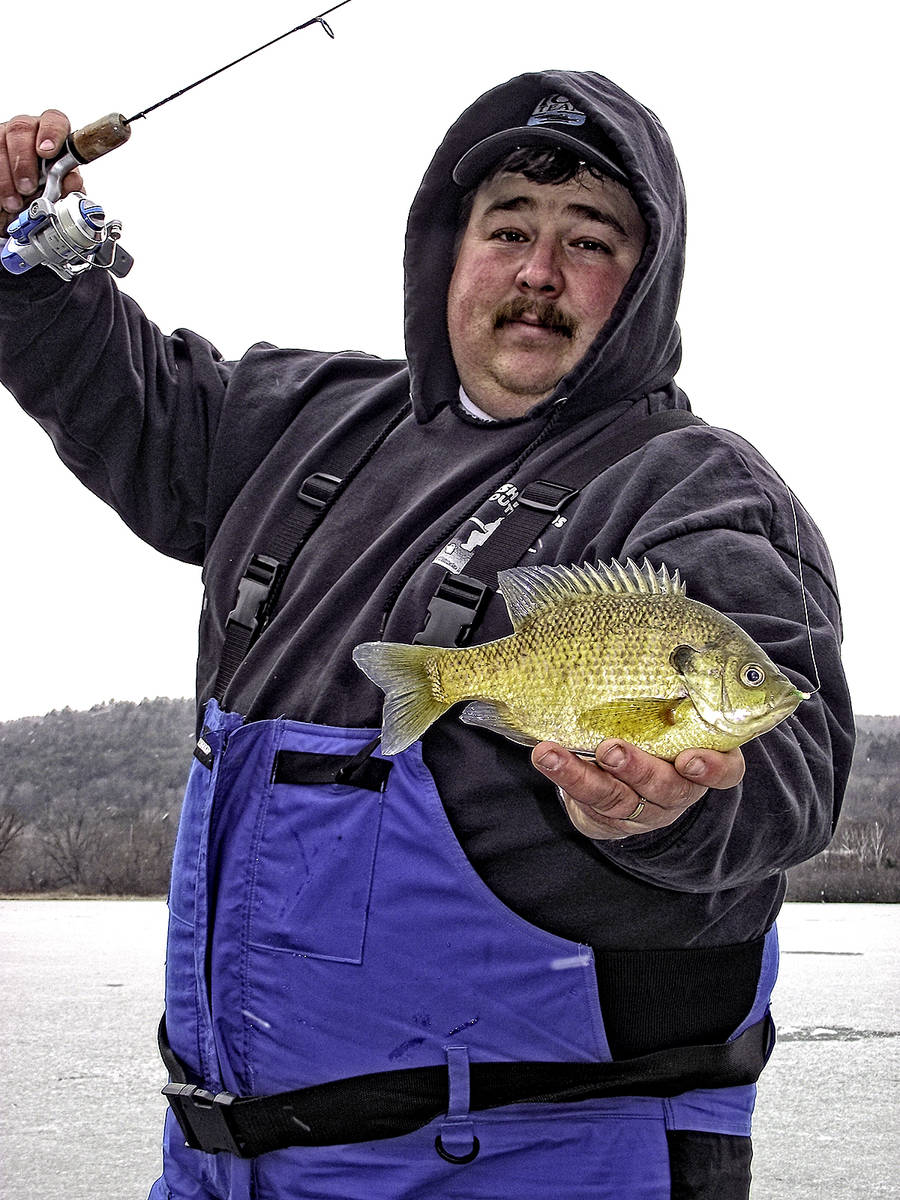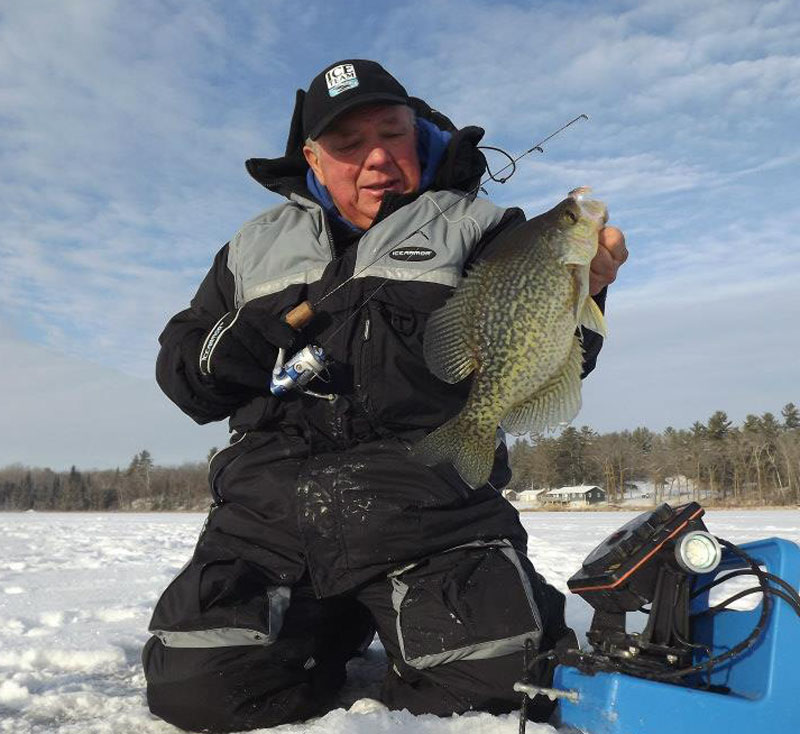Plastics in modern ice fishing, Part 2
 When we left off last time, you might have been surprised to learn that Dave Genz has become increasingly confident in soft plastics – and finds himself fishing with them more often (without giving up his beloved live bait). Several factors are at work, the most important of which is improved plastics.
When we left off last time, you might have been surprised to learn that Dave Genz has become increasingly confident in soft plastics – and finds himself fishing with them more often (without giving up his beloved live bait). Several factors are at work, the most important of which is improved plastics.
They’re softer and more realistic, meaning they look and feel better to the fish. With the options available these days, you can strive to match what fish are currently feeding on, in terms of size, shape and color. Watching talented tournament anglers pluck pressured fish off crowded spots, Genz gradually deepened his appreciation for the potential of plastics. Then, last winter, while fishing in Vermont with Jamie Vladyka, the “light bulb came on.”
The refined approach to plastics has to do with the fact that ice fishing is a matter of ‘dangling,’ more than anything else. You’re dangling baits downward and bringing them upward, striving to make them seem real even though they don’t travel outward very far.
Vladyka’s typical approach is to thread plastics on so they assume a ‘tails up’ posture. Rather than the plastic hanging horizontally on the hook shank, the tail (or tails) is angled upward.
“Jamie is the one who got me thinking this way,” credits Genz. “When the tails are upward like that, when you work it, it seems like it’s swimming up or down. You can go down and tap the bottom and make it look like this creature is swimming up out of the bottom. It’s more realistic than if it’s swimming around in circles by the bottom.”
When asked about his overall philosophy on plastics, Vladyka talks about matching the hatch, in the same way fly anglers do.
“We have spikes, wax worms, things like that,” he says, “and they catch fish, for sure. But that’s not what the fish are feeding on. With plastics, we’re matching what the fish are actually eating. Ultimately, we can hit the full color spectrum, including glow, with plastics. And we can scent the plastic so it smells like what the fish are eating.”
One area of intense study for Jamie has been what’s swimming and crawling around down there, and what he sees in fish stomachs. When he keeps fish to eat, he always checks what they’ve been eating. And he spends time with an underwater camera, to see what he can see in the prey department.
“I use (his underwater camera) to see what’s down there,” says Vladyka. “I go into the weeds and study what’s attached to the weeds. I put on a big jig and rip weeds to see what jumps off of them. I’m looking to see what those fish are there for. If crappies are feeding on pinheads or smelt fry or baby bluegills or some kind of insects, I try to figure that out. If I can match what they’re eating, in size and color, then our success rate goes up.
“I’m not saying you can’t catch fish with other things, but if we can match, we do much better.” (He says “our success” because he leads guide trips, at www.fishhounds.net.)
By studying what’s available to the fish at the moment, and thinking about how those prey items move in the water, he feels confident about appealing to the fish.
Jig as Delivery Mechanism
Vladyka thinks of the jig as simply the “delivery mechanism” for the plastic, the thing that gets the plastic up and down during trips to the potential fish zone. Even for bigger fish, he tends to use light jigs (especially in shallow water), so the plastic is given a chance to maximize its appeal. “I love tungsten jigs,” he says, “because they’re small for their weight and they get you down there quickly. They can bump down through weeds really well, too. I use them all the time.”
When fish are extra finicky and the bite’s tough to figure out, Jamie will downsize his delivery mechanism even more than usual, often using jigs like the smallest size of either the Drop or Epoxy Drop jig (Clam jigs that he’s most familiar with).
“Sometimes I use the plastic on a very light jig,” he says, “to slow the fall rate and keep the bait almost neutrally buoyant down there. When fish are extra finicky, they might come up to a bait and just blow on it. If a fish blows on your bait and it stays in position (because it’s heavy) they won’t bite it. But if a fish blows on it and it moves around in the water, the fish thinks it’s something real that belongs down there.”
 Presentation Approach
Presentation Approach
We decided to try something, in an effort to help you catch more fish even if you don’t go in-depth on underwater prey study. We asked Vladyka to give us his two favorite setups and presentations, one for generally active fish and one for finicky, tough-bite fish.
“Typically, I start off with a small tungsten horizontal jig and a plastic I can swim,” he said. “Color depends on where I’m fishing and what I’m fishing for. I usually start with a dark color.”
He likes a long (30-inch) rod for swimming plastics – just the rod, no spring bobber. His go-to plastic on this rig (as he tries for fish he believes will be generally cooperative) is a slender worm-style with a narrow paddle tail called the Spiiki. “First thing I usually do is bite about a quarter inch off, to shorten it up a bit,” says Vladyka. “That allows it to match up better with the small jig, so it hangs more horizontal, rather than the paddle tail hanging down too much. When you shorten the package up, you’re more apt to get the hook in the fish’s mouth better, instead of just the tail.”
As for how he works it: “I love swimming plastics. I try to be a happy little minnow swimming around down there, not in a straight line. I’m usually fishing outside or sitting on my snow machine, and I work the full hole, side to side, front to back, and the whole water column. I try to mimic what a minnow or tadpole would do down there. I work it as much left and right in the hole as up and down.”
So how about when the bite is tough?
When fish are reluctant to take much of anything, Vladyka uses a shorter rod with a spring-bobber on it. A lightweight jig is matched with his namesake plastic, the Jamei, featuring thin twin tails (that he angles upward most of the time) and a thicker body adorned with tentacles.
“That’s my go-to finessing bait,” he says. “If you can hold the jig almost completely still but keep the tails moving, that’s finessing in my book. That doesn’t mean I don’t move it around, because I do. I always tell my clients, ‘be the bait’ so they think about what it’s doing down there.
“How the fish responds on my flasher dictates what I do. If you slow down, but don’t stop, that might be just the right speed to keep the fish interested. I try to slow it down but keep it moving enough so that the fish reacts and tries to get it before it gets too far away.
“If the fish just sit there and won’t do much, I try to barely move it, just enough so the jig doesn’t spin. I want those hairs barely moving. Then I count on the fish putting it in their mouth to see what it is. A lot of times, they take it the first time and just hold it there, but the hook isn’t in their mouth. If it feels real to them, and smells real, there’s a good chance, when they take it the second time, they get it all the way in their mouth.”
Modern supple plastics have a huge advantage in this regard, says Vladyka, but it also means they’re often not as durable. “Fish will tear them up,” he says, “but I think that’s a good tradeoff for catching them.”
Indeed, says Genz, he has witnessed Jamie’s plastics system catch all types and sizes of fish, from panfish to bass, pike and walleyes.
“When you get it all right,” says Genz, “the right cadence, the right plastic, you discover the hook is way down in the fish’s mouth, where you need a disgorger to get it out. They’re eating the bait.”
In all ice fishing, you get upward and downward, but you mostly wish for outward. But the outward appearance of your bait, now that can be extremely realistic. And when it’s backed up by realistic feel, then you got something. Like a fish on the end of your line.
Note: Dave Genz, known as Mr. Ice Fishing, was the primary driver of the modern ice fishing revolution. He has been enshrined in the National Fresh Water Fishing Hall of Fame and Minnesota Fishing Hall of Fame for his contributions to the sport. For more fishing tips and to order his new info-packed book, Ice Revolution, go to www.davegenz.com.










